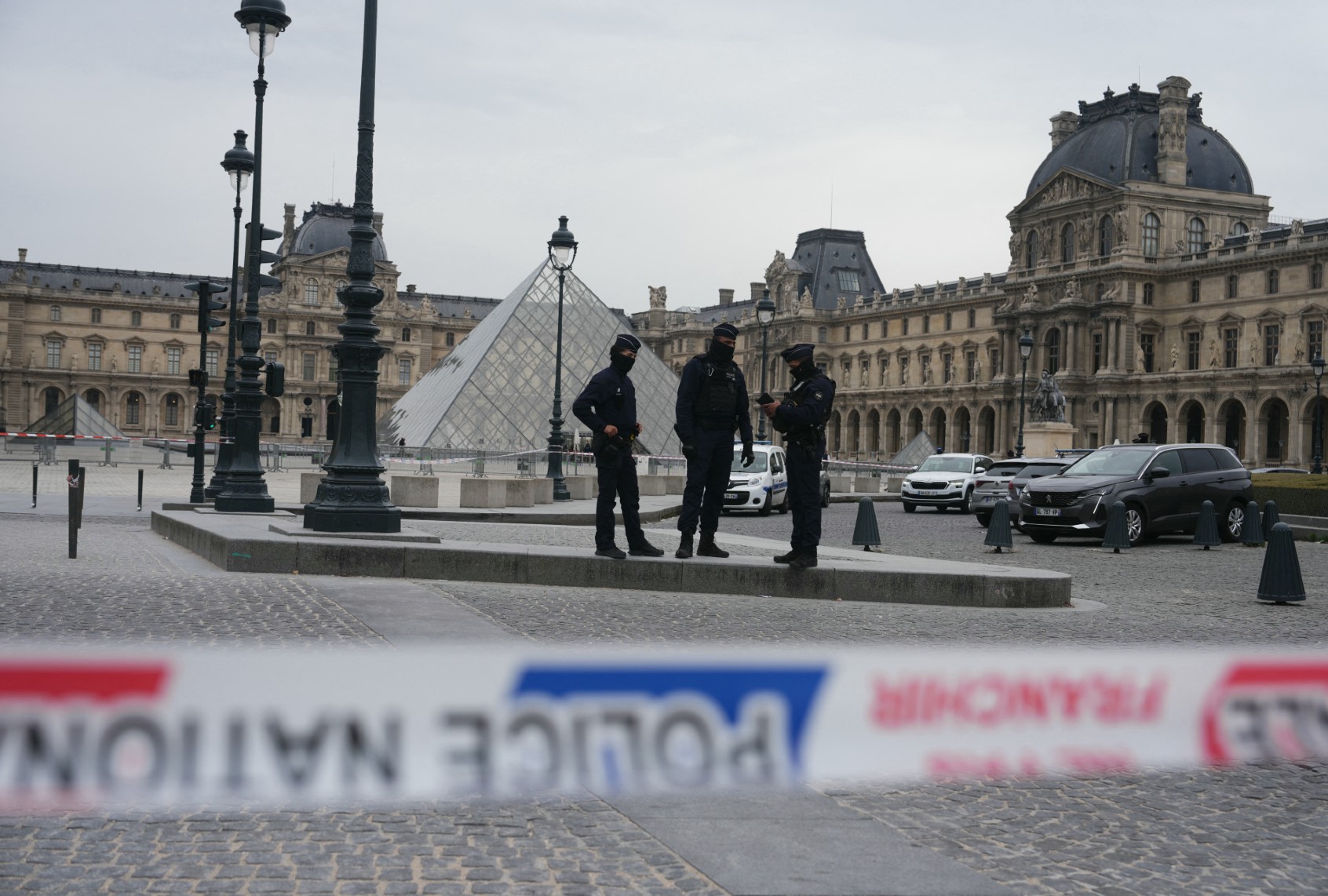When news broke last Sunday morning that Paris’ Louvre museum had been the site of a jewel heist, social media greeted it with a measure of giddy excitement. In a relentlessly bleak media landscape, here was some good old-fashioned crime involving priceless gems, glass-cutting gadgetry, and a motorbike escape. It was executed with no violence and no deaths. The details were simple but gripping. (A jewel heist? At 9:30 on a Sunday morning? While there were people in the Louvre? No one noticed the enormous ladder truck parked on the street under a balcony?) As a bonus, it faintly echoed the plot of the best Muppet movie. I’m not saying that people were happy the Louvre was burgled in broad daylight, of course. But sometimes it’s nice when the universe looks at the horrors of the world and throws us a sparkly cinematic whodunit to switch up the vibe.
“Heist narratives really hold our ambivalence about wealth and the wealthy. They are simultaneously odes to the wealthy and a middle finger to the wealthy. A heist is immediate wealth distribution; the wealth flows down like a waterfall.”
With a mostly clean getaway and no breaks in the case at press time, the heist of eight gem-laden pieces dating from the 19th century — including tiaras and brooches worn by Empress Eugénie, a sapphire tiara and necklace worn by Queen Hortense and Queen Marie-Amélie — has become a kind of void into which America’s 24-hour news cycle has been dumping every bit of speculation it can scare up. There are rumors of an inside job, theories about a connection to recent heists elsewhere in Paris, comments about the aptness of crown jewels being stolen on #NoKings weekend, snark about the thieves fumbling a ninth piece from the haul, Empress Eugénie’s crown, and plenty of chatter about who was behind the heist and what might happen to the estimated $102 million in big-ass gems. In the absence of facts, leads and clues, the comment sections of news reports and social-media posts were soon brimming with theories and conjecture. By Tuesday, some outlets were thirstily chasing down former art and jewel thieves in to get their expert insights on the mystery.
ABC News called on Myles Conner, the serial art thief who in 1975 walked out of Boston’s Museum of Fine Arts with a Rembrandt painting, intending to use it to bargain a lighter sentence on a previous art theft. Connor — who went to prison for several years but somehow ended up with a cash reward for returning the painting — apparently takes a dim view of the Louvre incident, calling the pieces “an immense collection of irreplaceable artifacts” with immeasurable value, and predicting that whomever absconded with them “[W]ill be vilified by the entire country because they are national treasures.”
CNN, meanwhile, checked in with Larry Lawton, a former jewel thief who complimented the thieves’ planning and use of equipment and said he was sure that they’d had some help on the inside. Lawton, a onetime Gambino associate who robbed jewelry stores along the Atlantic coast in the 1980s and ’90s before going to prison and subsequently launching a career as a motivational speaker, criticized the thieves’ “amateur move” of dropping one of the pieces — a crown, no less — during their getaway, bragging that in his illustrious career (“25 jewelry stores, $18 million dollars”) he would never have made such a gaffe.
But as we all wait for something concrete to emerge, reactions to the event have illuminated something of a shifting valence of heist narratives in the American cultural imagination. Much of this has to do with efforts by museums and other cultural institutions to be transparent about the cultural stewardship that in many cases has made them active accomplices to ongoing colonialist plunder and violence; it’s no longer possible to refer to crown jewels, for instance, without confronting the imperialist exploitation that produced their precious gems.
France’s legacy on this front is particularly bad: The country’s museums have a long and infamous history of hoarding artifacts and antiquities from its former African colonies; they have also been compelled to return numerous artworks that were looted from Jewish owners during the Nazi occupation of France. In 2021, French President Emmanuel Macron tasked Jean-Luc Martinez, the former director of the Louvre, with writing a report outlining criteria for the restitution of African artworks. Martinez stepped down from his position at the Louvre that same year when it came to light that he was involved in concealing the origin of artifacts smuggled from Egypt during the Arab Spring and subsequently purchased for the Louvre’s outpost in Abu Dhabi. (He was charged in 2023 with complicity in fraud.)

(DIMITAR DILKOFF/AFP via Getty Images) French police officers patrol in front of the Louvre Museum after it was robbed, with the Louvre Pyramid designed by Ieoh Ming Pei in the background, in Paris on October 19, 2025.
Meanwhile, even the fictional allure of the gentleman thief established over the decades in films from “The Thomas Crown Affair” and “Topkapi” to “The Italian Job” and “Gambit” has waned a bit. Audiences have always been encouraged to identify with these men, who aren’t common criminals but cultured rogues able to pull off daring heists because they’re already at ease in rarefied spaces and able to blend in with, outsmart and occasionally romance those standing in their way. Michael B. Jordan, who is currently directing and starring in a third remake of “The Thomas Crown Affair,” has said that the film “isn’t just another remake,” which is probably just as well: At a time when wealth inequality is endemic and rich men who think the rules don’t apply to them excruciatingly common, a disaffected billionaire stealing for kicks isn’t going to seem as charming as he once did.
The idea that historic preservation is best left to wealthy nations that make money putting the spoils of their imperial conquests on display has already aged poorly. The failures of security exposed by Sunday’s events just make that defense that much more hollow.
Which is not to suggest that Jordan’s Thomas Crown needs to resemble Killmonger, the revolutionary he played in 2018’s “Black Panther,” first seen reclaiming a Wakandan artifact from a London museum. But some of the comments on news stories about the Louvre robbery suggest that people will be a lot more inclined to cheer if it turns out to be something more than a mercenarily motivated event. Sure, a lot of our most enduring heist narratives center dapper, witty, but ultimately self-dealing thieves — but there are also plenty whose portrayal of crimes committed in the name of rectifying corporate malfeasance, historical evil or institutional corruption feel like they match the moment a bit better, from “Tower Heist” to “Inside Man” to TNT cult-favorite “Leverage.”
Start your day with essential news from Salon.
Sign up for our free morning newsletter, Crash Course.
“Heist narratives really hold our ambivalence about wealth and the wealthy,” says Aya De Leon, a UC Berkeley writing professor who is both the poet laureate of Berkeley and a prolific writer of novels in which heists are a form of social justice exacted by women of color on behalf of their communities. “They are simultaneously odes to the wealthy and a middle finger to the wealthy. A heist is immediate wealth distribution; the wealth flows down like a waterfall.” This particular heist is one that doesn’t strike De Leon as likely to have the Robin Hood trajectories of her own novels, but she does connect France’s colonial history to what she sees as a “deep arrogance” on the part of the Louvre regarding the lack of security in the Apollo gallery from which the jewels were taken. “It’s a real sense of entitlement,” she says. “Like, ‘These are our jewels, this is our heritage, of course these belong in our museum, and no one will try and take them from us.’ But they are the product of colonial empires. They were already stolen property. The idea that they [might be] dismantled and the jewels cut down and sold — there’s a symbolism to that.”
We need your help to stay independent
The embarrassment evinced in the response from French officials suggests that they see that symbolism too. The heist at the Louvre comes after a string of other museum ransackings in the country: Last month, at Paris’ Museum of Natural History, where thieves made off with roughly $700,000 worth of gold nuggets, and, in a separate incident, a museum in Limoges was infiltrated by thieves who escaped with between $7 and $9 million in fine porcelain. Like other former colonial powers, France has argued that looted art and artifacts should remain under their stewardship for reasons of safety and security; the fact that the pieces stolen this weekend were neither safe nor secure — and also not privately insured — blows a hole in that justification. This, too, is arrogance: The idea that historic preservation is best left to wealthy nations that make money putting the spoils of their imperial conquests on display has already aged poorly. The failures of security exposed by Sunday’s events just make that defense that much more hollow.
Eventually, maybe, we’ll find out what and who were behind the Louvre heist, but I wouldn’t count on a righteous or feel-good explanation; more likely, it’s simply an event motivated by greed, maybe on the part of the crew that executed it and maybe on the part of the person who ordered and bankrolled it. In the meantime, Kelly Reichardt’s brand-new film, “The Mastermind,” offers up a new riff on the museum job in which the thief isn’t dapper and the motive isn’t righteous. If there were ever a time when it feels not just timely but necessary to strip heists of their glamour, now feels right.
Read more
about museums


